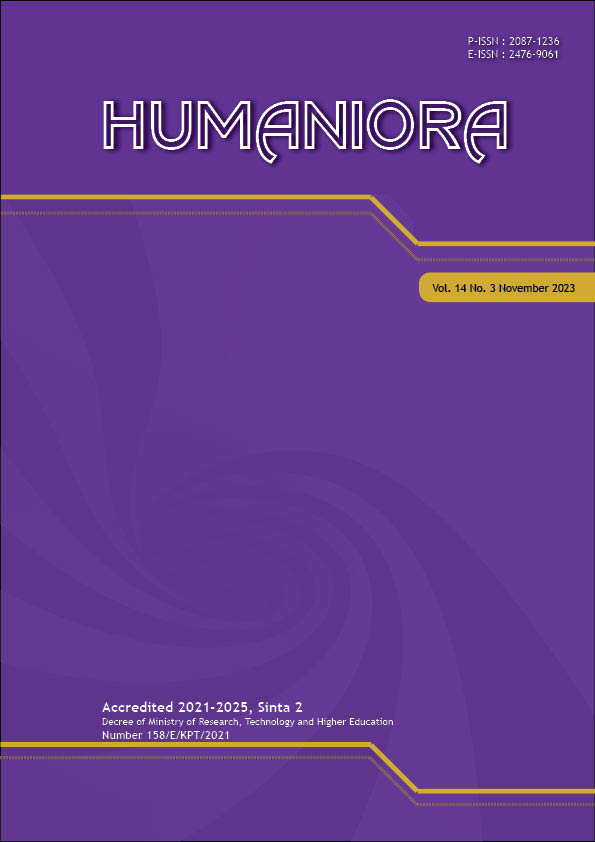Cultural Character Analysis on Architectural Elements of the Chinese Temples’ Buildings before the 19th Century in Central Java
DOI:
https://doi.org/10.21512/humaniora.v14i3.8061Keywords:
architectural design, Chinese temples, Sino-Indonesian cultural heritageAbstract
The research provided an in-depth exploration of the architectural nuances of pre-19th century Chinese temples in Central Java, Indonesia, emphasizing their cultural significance and relevance. A detailed examination of a range of temples identified unique architectural features that reflected a sophisticated synthesis of Chinese cultural elements and local Javanese traditions. Applying a qualitative method, the research integrated historical scrutiny with architectural analysis, meticulously examining stylistic attributes, construction methodologies, and decorative patterns typical of these temples. The key discoveries highlight an intricate amalgamation of traditional Chinese architectural principles with native materials and craftsmanship, culminating in a distinctive, hybrid architectural form. This fusion not only symbolizes the cultural convergence and assimilation between Chinese immigrants and the indigenous Javanese during the pre-colonial era but also underscores the role of these temples as pivotal preservers of Chinese cultural heritage in Java. Furthermore, the research contributes to a deeper understanding of the diversity within architectural practices and offers insightful perspectives on the historical and socio-cultural dynamics in Central Java. The novelty of the research is anchored in its focused examination of a historically and geographically specific context, its interdisciplinary and thorough approach, the revelation of a unique hybrid architectural style, and its significant insights into the cultural and sociological dimensions of Central Java’s architectural legacy.
References
Astutik, J., & Ramadhoan, R. I. (2020). Shared Identity as Social Capital in The Chinese-Javanese Relations in Malang City, Indonesia. In Journal of Social and Political Sciences (Vol. 3, Issue 3). Asian Institute of Research. https://doi.org/10.31014/aior.1991.03.03.224
Cheng, H., & Worrall, J. (2021). Unfolding China’s Urban Development: The Implementation of Public Art in Beijing and Shanghai. In Journal of Chinese Architecture and Urbanism (pp. 1–14). AccScience Publishing. https://doi.org/10.36922/jcau.v3i1.1025
Chong, W.-L. (2018). A Short History of the Ethnic Chinese in Indonesia. In Chinese Indonesians in Post-Suharto Indonesia (pp. 25–40). Hong Kong University Press. https://doi.org/10.5790/hongkong/9789888455997.003.0002
Fukuoka, Y., & Verico, K. (2016). Indonesia – China Economic Relations in the Twenty-First Century : Opportunities and Challenges. https://doi.org/10.1007/978-3-319-24232-3
Hagras, H. M. (2020). THE FUNCTIONS AND SYMBOLISM OF CHINESE MINARETS: A CASE STUDY OF THE HUAISHENG GUANGTA. In Journal of Islamic Architecture (Vol. 6, Issue 2, pp. 68–76). Maulana Malik Ibrahim State Islamic University. https://doi.org/10.18860/jia.v6i2.10209
Hou, Y., Li, A., & Mei, S. (2021). Learning from Chinese traditional architecture: field test and CFD modelling of ventilation enhancement techniques in southern Chinese houses. In International Journal of Ventilation (pp. 1–18). Informa UK Limited. https://doi.org/10.1080/14733315.2021.1876406
Kwanda, T. (2020). Adaptive Reuse and Interventions of Chinese Architectural Heritage in the City of Lasem, Indonesia. In International Journal of Environmental Science & Sustainable Development (Vol. 5, Issue 1, p. 68). International Experts for Research Enrichment and Knowledge Exchange (IEREK). https://doi.org/10.21625/essd.v5i1.718
Li, M. (2020). Looking back to Quiddity Between Traditional Chinese Architecture and Ancestor Worship. Journal of Chinese Architecture and Urbanism (pp. 1–14). AccScience Publishing. https://doi.org/10.36922/jcau.v2i1.908
Li, F., & Nishizawa, Y. (2021). A Study On The Actual Studying Condition Of Chinese Architecture Students Coming To Japan In The First Half Of The 20th Century. In Journal of Architecture and Planning (Transactions of AIJ) (Vol. 86, Issue 780, pp. 637–647). Architectural Institute of Japan. https://doi.org/10.3130/aija.86.637
Rukayah, R. S., & Abdullah, M. (2021). In Searching Architecture and City Pattern as the Mark of Old Coastal Semarang, Indonesia. In Journal of Architectural Design and Urbanism (Vol. 3, Issue 2, pp. 72–83). Institute of Research and Community Services Diponegoro University (LPPM UNDIP). https://doi.org/10.14710/jadu.v3i2.10687
Shen, Y., Zhang, E., Feng, Y., Liu, S., & Wang, J. (2020). Parameterizing the Curvilinear Roofs of Traditional Chinese Architecture. In Nexus Network Journal (Vol. 23, Issue 2, pp. 475–492). Springer Science and Business Media LLC. https://doi.org/10.1007/s00004-020-00512-1
Wei, H., & Jiang, W. (2020). Translation of the ‘Landscape Architecture’ Into Chinese and How to Build the Discipline of Landscape Architecture in China? In International Research in Education (Vol. 8, Issue 1, p. 104). Macrothink Institute, Inc. https://doi.org/10.5296/ire.v8i1.16381
Wijayanti, R. (2021). The influence of traditional javanese architecture in chinese-style house in Lasem. In IOP Conference Series: Earth and Environmental Science (Vol. 778, Issue 1, p. 12033). IOP Publishing. https://doi.org/10.1088/1755-1315/778/1/012033
Wu, Y. (2020). On the Inheritance Strategy of Excellent Chinese Traditional Culture of Overseas Chinese under the Background of Network Teaching. In Education Reform and Development (Vol. 2, Issue 2). Bio-Byword Scientific Publishing, Pty. Ltd. https://doi.org/10.26689/erd.v2i2.2054
Zhu, H., Liu, S., Jia, X., & Chang, J. (2019). Urbanization mechanism study under the dynamic of state capital. A Case Study about Northeast China with the Construction of the Chinese Eastern Railway in the Early of 20th Century. In Proceedings of the 55th ISOCARP World Planning Congress. ISOCARP. https://doi.org/10.47472/lqzu4940
Downloads
Published
How to Cite
Issue
Section
License
Copyright (c) 2023 Irina Mildawani Toha, Djoko Darmawan

This work is licensed under a Creative Commons Attribution-ShareAlike 4.0 International License.
Authors who publish with this journal agree to the following terms:
a. Authors retain copyright and grant the journal right of first publication with the work simultaneously licensed under a Creative Commons Attribution License - Share Alike that allows others to share the work with an acknowledgment of the work's authorship and initial publication in this journal.
b. Authors are able to enter into separate, additional contractual arrangements for the non-exclusive distribution of the journal's published version of the work (e.g., post it to an institutional repository or publish it in a book), with an acknowledgment of its initial publication in this journal.
c. Authors are permitted and encouraged to post their work online (e.g., in institutional repositories or on their website) prior to and during the submission process, as it can lead to productive exchanges, as well as earlier and greater citation of published work.
USER RIGHTS
All articles published Open Access will be immediately and permanently free for everyone to read and download. We are continuously working with our author communities to select the best choice of license options, currently being defined for this journal as follows: Creative Commons Attribution-Share Alike (CC BY-SA)




















